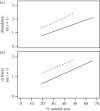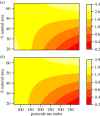Negative effects of pesticides on wild bee communities can be buffered by landscape context
- PMID: 26041355
- PMCID: PMC4590442
- DOI: 10.1098/rspb.2015.0299
Negative effects of pesticides on wild bee communities can be buffered by landscape context
Abstract
Wild bee communities provide underappreciated but critical agricultural pollination services. Given predicted global shortages in pollination services, managing agroecosystems to support thriving wild bee communities is, therefore, central to ensuring sustainable food production. Benefits of natural (including semi-natural) habitat for wild bee abundance and diversity on farms are well documented. By contrast, few studies have examined toxicity of pesticides on wild bees, let alone effects of farm-level pesticide exposure on entire bee communities. Whether beneficial natural areas could mediate effects of harmful pesticides on wild bees is also unknown. Here, we assess the effect of conventional pesticide use on the wild bee community visiting apple (Malus domestica) within a gradient of percentage natural area in the landscape. Wild bee community abundance and species richness decreased linearly with increasing pesticide use in orchards one year after application; however, pesticide effects on wild bees were buffered by increasing proportion of natural habitat in the surrounding landscape. A significant contribution of fungicides to observed pesticide effects suggests deleterious properties of a class of pesticides that was, until recently, considered benign to bees. Our results demonstrate extended benefits of natural areas for wild pollinators and highlight the importance of considering the landscape context when weighing up the costs of pest management on crop pollination services.
Keywords: agroecosystem; apple; native bees; orchards; pest management.
© 2015 The Author(s) Published by the Royal Society. All rights reserved.
Figures



References
-
- Ascher, JS& Pickering, J. 2015. Discover life bee species guide and world checklist (Hymenoptera: Apoidea: Anthophila). [Updated 2015 Mar 9; cited 2015 May 18]. See: http://www.discoverlife.org/mp/20q?/guide=Apoideaspecies.
-
- National Research Council. 2007. Status of pollinators in North America. Washington, DC: The National Academies Press.
Publication types
MeSH terms
Substances
Associated data
LinkOut - more resources
Full Text Sources
Other Literature Sources
Molecular Biology Databases
